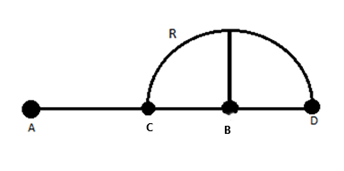
Charges $+q$ and $-q$ are placed at points A and B respectively which are a distance $2L$ apart, C is the midpoint between A and B. The work done in moving a charge $+Q$along the semicircle CRD is
A. $\dfrac{qQ}{2\pi {{\varepsilon }_{0}}L}$
B. $\dfrac{qQ}{6\pi {{\varepsilon }_{0}}L}$
C. $-\dfrac{qQ}{6\pi {{\varepsilon }_{0}}L}$
D. $\dfrac{qQ}{4\pi {{\varepsilon }_{0}}L}$


Answer
554.4k+ views
Hint: The work done by an electric force is proportional to the amount of the moved charge and proportional to the difference of potentials between the starting point and the destination.
${{W}_{(r)}}=Q\times {{V}_{(r)}}$
Potential at a distance ‘r’ from the center of a dipole is given by:
\[{{V}_{\left( r \right)}}=\dfrac{k2aq\cos \theta }{{{r}^{2}}-{{a}^{2}}{{\cos }^{2}}\theta }\]
Where;
2a is distance between the two charges of the dipole
q is the magnitude of charge of the dipole
$k=\dfrac{1}{4\pi {{\varepsilon }_{o}}}$
Complete answer:
It is given in the question that $'2L'$is the distance between the two charges of the dipole with point C as the center of the dipole.
Since the external charge $'+Q'$ undergoes a semicircular path from C to a point D with the center of the trajectory at point B. Hence, the radius of this semicircular path will be $'L'$.
Potential at the center of the dipole is $0$ .
This is because, at C:
${{V}_{C}}={{V}_{+q}}+{{V}_{-q}}$
\[{{V}_{C}}=\dfrac{kq}{L}+\dfrac{k(-q)}{L}\]
Therefore,
${{V}_{C}}=0$
Potential at point D due to the dipole is:
${{V}_{D}}=\dfrac{k(2Lq)\cos \theta }{{{(2L)}^{2}}-{{(L\cos \theta )}^{2}}}$
Since D lies on an axial position with respect to the dipole, $\theta ={{180}^{o}}$
Therefore $\cos \theta =-1$
$\Rightarrow $${{V}_{D}}=-\dfrac{k(2Lq)}{3{{(L)}^{2}}}$
$\because $$k=\dfrac{1}{4\pi {{\varepsilon }_{o}}}$
${{V}_{D}}=-\dfrac{(2q)}{4\pi {{\varepsilon }_{o}}(3L)}$
${{V}_{D}}=-\dfrac{(q)}{6\pi {{\varepsilon }_{o}}(L)}$
The work done to move $'+Q'$ from point C to D is:
${{W}_{CD}}=Q[{{V}_{D}}-{{V}_{c}}]$
${{W}_{CD}}=Q[-\dfrac{(q)}{6\pi {{\varepsilon }_{o}}(L)}-0]$
${{W}_{CD}}=-\dfrac{Q(q)}{6\pi {{\varepsilon }_{o}}(L)}$
Hence the correct option will be option C) $-\dfrac{Q(q)}{6\pi {{\varepsilon }_{o}}(L)}$
Note:
The work done to move charge $'+Q'$ from point C to point D is independent of the path undertaken and depends only on the initial and final positions of the charge.
Since the point D is closer to $-q$, the net potential at point D will be negative in magnitude.
${{W}_{(r)}}=Q\times {{V}_{(r)}}$
Potential at a distance ‘r’ from the center of a dipole is given by:
\[{{V}_{\left( r \right)}}=\dfrac{k2aq\cos \theta }{{{r}^{2}}-{{a}^{2}}{{\cos }^{2}}\theta }\]
Where;
2a is distance between the two charges of the dipole
q is the magnitude of charge of the dipole
$k=\dfrac{1}{4\pi {{\varepsilon }_{o}}}$
Complete answer:
It is given in the question that $'2L'$is the distance between the two charges of the dipole with point C as the center of the dipole.
Since the external charge $'+Q'$ undergoes a semicircular path from C to a point D with the center of the trajectory at point B. Hence, the radius of this semicircular path will be $'L'$.
Potential at the center of the dipole is $0$ .
This is because, at C:
${{V}_{C}}={{V}_{+q}}+{{V}_{-q}}$
\[{{V}_{C}}=\dfrac{kq}{L}+\dfrac{k(-q)}{L}\]
Therefore,
${{V}_{C}}=0$
Potential at point D due to the dipole is:
${{V}_{D}}=\dfrac{k(2Lq)\cos \theta }{{{(2L)}^{2}}-{{(L\cos \theta )}^{2}}}$
Since D lies on an axial position with respect to the dipole, $\theta ={{180}^{o}}$
Therefore $\cos \theta =-1$
$\Rightarrow $${{V}_{D}}=-\dfrac{k(2Lq)}{3{{(L)}^{2}}}$
$\because $$k=\dfrac{1}{4\pi {{\varepsilon }_{o}}}$
${{V}_{D}}=-\dfrac{(2q)}{4\pi {{\varepsilon }_{o}}(3L)}$
${{V}_{D}}=-\dfrac{(q)}{6\pi {{\varepsilon }_{o}}(L)}$
The work done to move $'+Q'$ from point C to D is:
${{W}_{CD}}=Q[{{V}_{D}}-{{V}_{c}}]$
${{W}_{CD}}=Q[-\dfrac{(q)}{6\pi {{\varepsilon }_{o}}(L)}-0]$
${{W}_{CD}}=-\dfrac{Q(q)}{6\pi {{\varepsilon }_{o}}(L)}$
Hence the correct option will be option C) $-\dfrac{Q(q)}{6\pi {{\varepsilon }_{o}}(L)}$
Note:
The work done to move charge $'+Q'$ from point C to point D is independent of the path undertaken and depends only on the initial and final positions of the charge.
Since the point D is closer to $-q$, the net potential at point D will be negative in magnitude.
Recently Updated Pages
Master Class 12 Economics: Engaging Questions & Answers for Success

Master Class 12 Maths: Engaging Questions & Answers for Success

Master Class 12 Biology: Engaging Questions & Answers for Success

Master Class 12 Physics: Engaging Questions & Answers for Success

Master Class 8 Maths: Engaging Questions & Answers for Success

Class 8 Question and Answer - Your Ultimate Solutions Guide

Trending doubts
What is meant by exothermic and endothermic reactions class 11 chemistry CBSE

Which animal has three hearts class 11 biology CBSE

10 examples of friction in our daily life

One Metric ton is equal to kg A 10000 B 1000 C 100 class 11 physics CBSE

1 Quintal is equal to a 110 kg b 10 kg c 100kg d 1000 class 11 physics CBSE

Difference Between Prokaryotic Cells and Eukaryotic Cells




